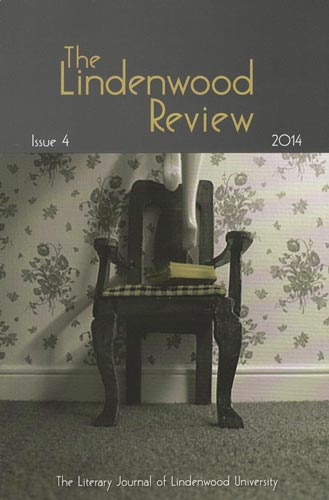The Lindenwood Review – 2014
Beth Mead, the editor of The Lindenwood Review, asserts that “the pieces we’ve selected this year are fragmented, showing us moments caught and suspended for our study, helping us find some truths about life through an unexpected point of view.” The Lindenwood Review most certainly holds true to Mead’s statement as each work within the magazine not only enticed me to read its content, but drew me to a level of self-reflection that left me wonderstruck.
Beth Mead, the editor of The Lindenwood Review, asserts that “the pieces we’ve selected this year are fragmented, showing us moments caught and suspended for our study, helping us find some truths about life through an unexpected point of view.” The Lindenwood Review most certainly holds true to Mead’s statement as each work within the magazine not only enticed me to read its content, but drew me to a level of self-reflection that left me wonderstruck.
Within the fiction section, my attention was immediately drawn to Joe Baumann’s piece “The Glass Spider,” in which I journeyed into the life of Aunt Mary and how she dealt with her husband’s death through buying and placing glass spiders all around her home. Upon reading the story, it reminds me that not all stories can end on a happy note but there is always still a glimmer of hope. Along with other pieces in this section such as “Reggie and Sophia” by Kate LaDew, “Lit Up from Inside” by Kathleen Lindstrom, and “Paper Waltz in Monsoon” by Bleuzette La Feir, each story deals with the theme of loss and grief, while also analyzing the human consciousness. Even though most of the stories within this section do cover deep and dark themes, their authors are still able to convey such subjects in a beautiful way.
One story in particular that I enjoyed the most was “Lit Up From Inside” by Kathleen Lindstrom. Within this story, the main character is showing signs of becoming mentally ill. Throughout the piece, there are such beautifully composed sentences such as, “She hears the moon moan. She’s sure of it,” or the other breathtaking sentence, “She longs to plunge into that beauty, to feel the final heat of these dying days, to know what it’s like to flirt with the sun.” Through such craft, Lindstrom was able to transport me into the mind of the main character while also causing me to admire her writing style at the same time.
Whenever I read a poem, I always tend to enjoy a poem that leaves a lasting effect upon the reader and causes me to ponder upon the human psyche. The poem “The Serial Killer’s Parents, Afterward” by Kate Peper most certainly did this for me as I experienced how the parents questions themselves as to why their son would kill someone—truly horrific and yet cathartic. Another poem that left me pacific was “Are You Sleeping” by Ann Minoff. With her simple lines of “Are you sleep / no / who am I / my daughter” she really strikes me into what it is like to live with someone who is possibly losing their memory.
Usually nonfiction is not my most favorite genre; however, I honestly did not find myself saying this with the essay section in Issue 4 of The Lindenwood Review. When reading the piece “Mars” by Susan Rava, I was impressed with how the author was able to take an object so simple like a talking shower curtain and use it as a metaphor for her own life experiences. “Complicated Footwork” by Patricia Feeney is a whimsical piece of a married couple and how their love triumphs over their marital problems. The main character, in the face of death, is able to see how much her husband truly cares for her, and realizes that her troubles within her marriage are so minor.
A unique feature about The Lindenwood Review is their Lyric Essay Contest. The winner in this issue is Christine Stewart-Nunez and her essay “Disordered.” The piece emphasizes the study of languages while also applying such knowledge to her son Holden, who suffers from Landau-Kleffner Syndrome. Stewart-Nunez explains how the disorder affects the different parts of the brain that control speech and comprehension. The essay itself exemplifies the seriousness of the disorder while also showing how language has affected her life and her son’s life—certainly an interesting and educational read. There are also honorable mentions from the contest that include essays from Brenna J. Conley, Peter E. Murphy, Aileen Hunt, Virginia Newell, and Dawn Paul.
The cover photo of the magazine and photographs spread throughout the issue are by Eve Jones, the former Director of the MFA program at Lindenwood University. Although The Lindenwood Review is only four years old, its Spring 2014 issue does not disappoint. I would definitely recommend this magazine to all readers and writers, and I cannot wait to see what the future holds for this magazine.
[www.lindenwood.edu/lindenwoodReview]
Reviewer bio: Lindsey Holt received a B.A. in Elementary Education and English, with a minor in Southern Studies from Coastal Carolina University, and is currently a graduate student in the Master of Arts in Writing program at Coastal. She has worked as an editorial assistant for Waccamaw and enjoys reading and writing poetry and fiction.





